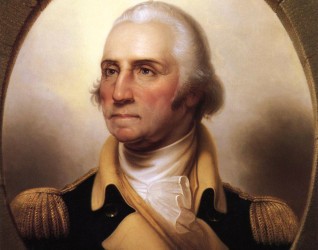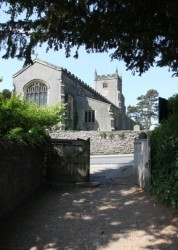
George Washington the first President of the United States was a rebel when it came to his family roots. Originating in Northumbria his family served the Christianity of King Oswald, the man responsible for the installation of Christianity in Saxon England at Lindisfarne back in the seventh century AD. King Oswald on his way to wage war against the Mercian pagan king Penda traversed through Lancashire following the old Roman roads passing though my home town of Oswaldtwistle which is named after the Christian saint.
King Oswald did battle with Penda at Oswestry in North Wales and was killed in battle but his self sacrifice opened the door for Christianity to take root in England.
Another important village in Lancashire connected to Saint Oswald is Warton near Carnforth which today is a quiet sort of spot with some pretty stone cottages, some dating back to the 17th century. The name Warton probably signifies that a watch was kept here in more troubled times, but where Reivers once rampaged day-trippers now pass through heading for Silverdale.
 But there is a very strange anomaly occurs every 4th of July as those visitors may spot an incongruous sight: an ancient English parish church flying the US flag. Shifting from spiritual to spirituous they’ll notice the pub opposite has an uncommon name, The George Washington. This is Warton’s big story. it was for centuries home to the Washington family.
But there is a very strange anomaly occurs every 4th of July as those visitors may spot an incongruous sight: an ancient English parish church flying the US flag. Shifting from spiritual to spirituous they’ll notice the pub opposite has an uncommon name, The George Washington. This is Warton’s big story. it was for centuries home to the Washington family.
The Washington’s were good beneficiaries to this building, they are said to have funded the tower in the 15th century, says Father Damian Porter of St Oswald’s in Warton. (left) Several generations of the family lived here.
One John de Wessington ventured into Lancashire in the mid-13th century from the Northumbrian County; Lawrence Washington in 1300 was apparently the first to live in Warton. Evidence of their residence includes a Washington seal on a Duchy of Lancaster document from 1401 to be found in the Public Records Office.
The Washington crest today is a much-eroded stone now kept inside the tower whose outside it previously adorned. In heraldic terms the shield contains three mullets in chief and two bars, or in layman’s language three stars above two stripes the supposed origin of the American flag. The stars can still be easily discerned on the weathered stone, the stripes however are barely visible.
Over the road from the church within it’s beautifully kept graveyard that thoroughfare with the fittingly American name Main Street are the ruins of the vast 13th century rectory where doubtless many Washington’s were welcomed in its heyday, when Warton was a local market centre. It’s a lovely backwater these days, the streets of grey-stone cottages little troubled by traffic.
The family connection lasted long after George Washington’s direct ancestors left the village for Oxfordshire where they would receive patronage from King Henry VIII, and in 1659 they would leave for Virginia perhaps under the auspices of the Virginia Company. Thomas Washington was rector here in the 19th century, he died in 1823 and you can see his gravestone outside, says Father Damian. What must Thomas have thought of his distant rebellious cousin after whom a capital city was named? The stone is shared with his aunt, Mrs Elizabeth Washington, whose death in 1751 spared her the dilemma of pride in or prejudice against The Father of a Country that supposedly humiliated hers.
Local legend has it that the flag was flown over the White House, or possibly the Capitol Building, before it crossed the Atlantic.
Further Study
Oswald of Northumbria
Tags : American Flag Capitol Building Elizabeth Washington George Washington John de Wessington King Oswald Lancashire Lawrence Washington Silverdale